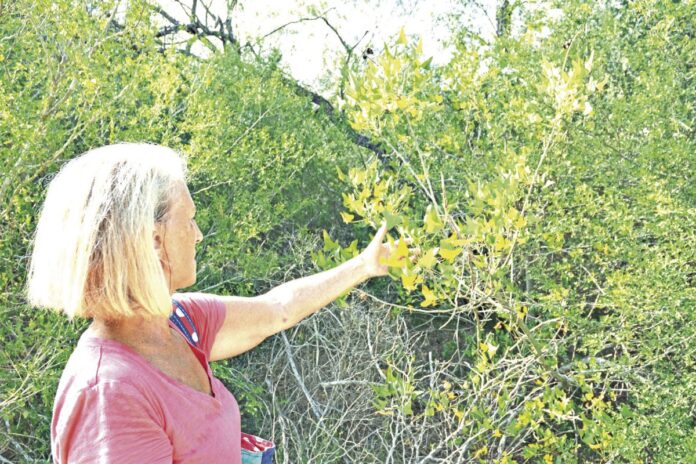HARLINGEN — Is it a flower or a weed, you ask.
Both, comes the exasperating reply.
The diversity of the native plants of the Rio Grande Valley makes being an amateur botanist a dream hobby here, although starting out on the trail to mastering the craft can be daunting.
Texas Master Naturalists Anita Westervelt and Barbara Peet can make identification of native and even non-native plants easier to digest with their twice-monthly plant walks at Hugh Ramsey Nature Park.
Yesterday morning, Westervelt was giving a preview of their tours, starting along the south edge of the Hugh Ramsey parking lot.
“If you look at this whole row of trees, the only thing that’s different is a little bit of color, green color differentiation,” she said, noting that visual identification is often combined with tactile input, too. “For instance, this is the wild olive, if you feel the leaf, the top of it is rough but the bottom is smooth, as opposed to an anacua, where both sides of the leaf feel like sandpaper.”
Moving toward the trailhead of Ebony Loop, more trees stand in the path.
“This beautiful Texas ebony will keep its seed pods for one year before they drop,” Westervelt said. “One of the quickest ways to tell an ebony tree is to look at the ground with old seed pods all around it.
“Those were, throughout the ages, used as a coffee substitute,” she said.
“Is this a palo verde?” came a hesitant question.
“No, this is a cedar elm,” she said.
“Right next to it though is a brasil, b-r-a-s-i-l, which you can tell from across the parking lot because of its beautiful lime-green color,” Westervelt said. “But if you get really close, it’s got wicked, wicked thorns.
“It blooms after rain and then it’ll continue to berry and when the berries turn dark, they’re ripe,” she said. “Bird food. Nature’s bird food.”
As we move down the Ebony Loop trail, we make forays into various specialty gardens carved from the thorn scrub along the way. Many of the plants have small signs with their common and scientific names.
The Betty McEnery Memorial Garden, Hachinal Corner, Alicoche Alley, Tom Wilson Garden and Robert Runyon Garden all come to pass, with each contributing some specialized native plants or attractants for birds or butterflies.
“This is a snake eyes bush, it’s a female because it berries, but the berries aren’t here yet, although they were in October last year,” Westervelt said. “What’s really fun about this shrub is that the berries are itty-bitty and there are a whole cluster of them.
“They’re opaque, and inside, you can see one tiny black seed, hence the name snake eyes,” she added. “I like to talk about it on my Halloween walk.”
Who are the naturalist?
Both Westervelt and Peet are certified Texas Master Naturalists, which is a volunteer educational program of the Texas A&M University AgriLife Extension Service and Texas Sea Grant. There’s our Rio Grande Valley Chapter and about 47 others statewide.
Members from the local chapter are active at Hugh Ramsey, and each Thursday a crew arrives to put in three hours of work in the mornings at different sites within the park. They provide upkeep for most of the special memorial gardens.
“This is a really exciting tree for native plant lovers — Esenbeckia runyonii,” Westervelt said, pointing to a 12-foot tree named in honor of Robert Runyon, the former Brownsville mayor, photographer and self-taught botanist.
The tree with its waxy, dark green leaves looks like a peach, although it is actually a member of the citrus family and called limoncillo in Spanish, or little lemon.
“They thought they were extinct when Mike Heep discovered a colony of them, I believe around Brownsville, and he was able to propagate them and he does now sell them,” Westervelt said.
“But it’s rare, and it’s exciting that it’s still here,” she said.
Westervelt said she and Peet are considering tailoring some of their nature “walks” to the parking lot at Hugh Ramsey. That way, she says, people who may have mobility issues can still learn about the scores of different plant species which grow along the perimeter of the lot, or in the bio-retention structure right in the middle of the lot.
“We could talk for two hours just by looking at the plants and trees in the parking lot,” she said.




